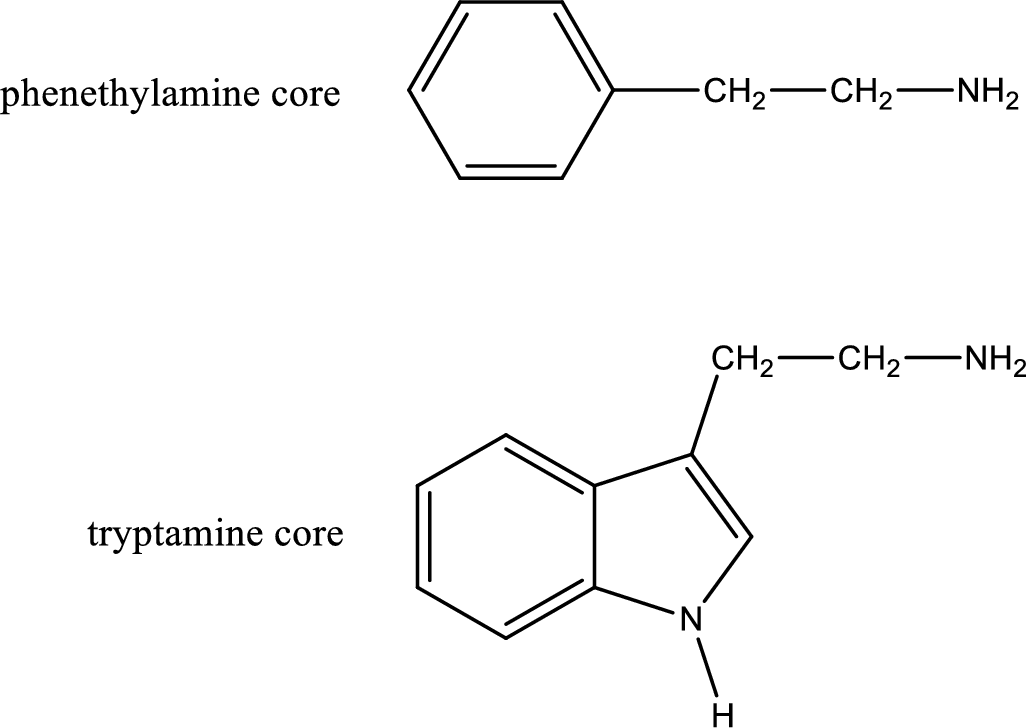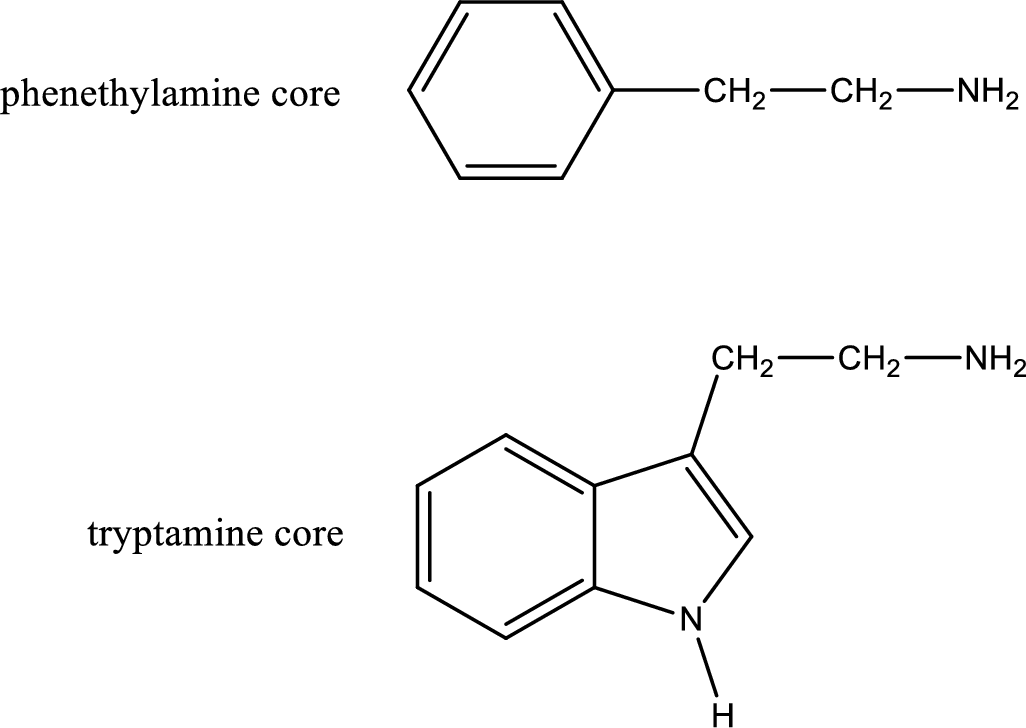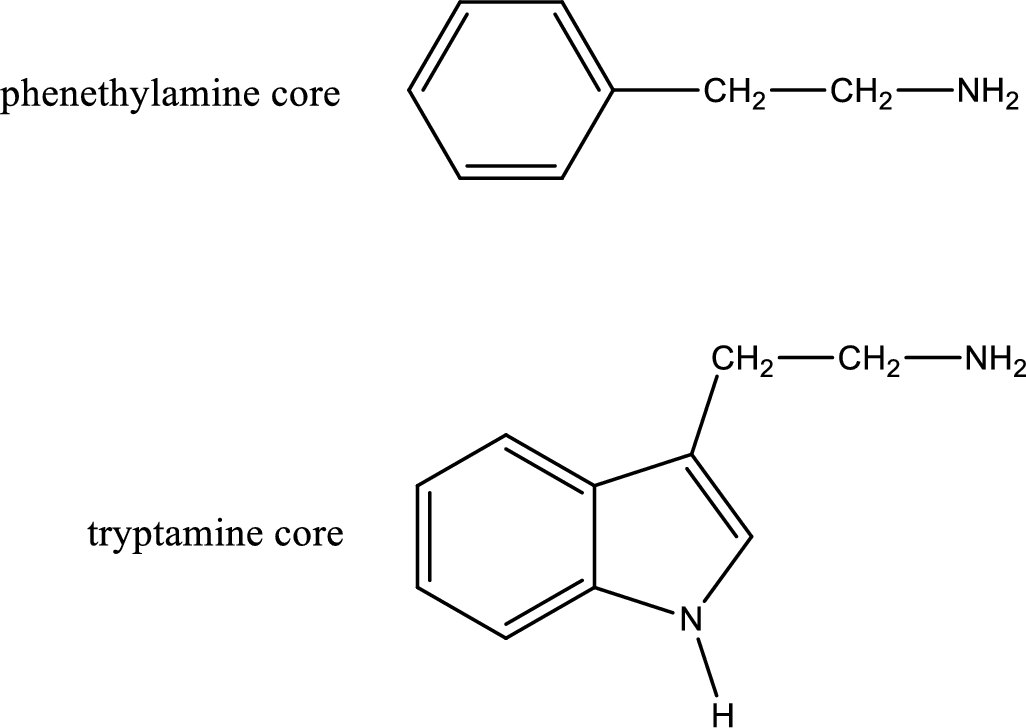
(a)
Interpretation:
Dopamine has a phenethylamine core or a tryptamine core has to be indicated.
Concept Introduction:
Generally

There are three types of effects that an amine can exert. They are neurotransmitters, central nervous system stimulants and decongestants. Neurotransmitters are the substances that are present in human body that help in passing impulse of nerves from one cell to another. Central nervous stimulants are the substances that help in speeding up of physical and mental processes. Decongestant is a substance that is used to relieve nasal congestion.
(b)
Interpretation:
Epinephrine has a phenethylamine core or a tryptamine core has to be indicated.
Concept Introduction:
Generally amines are toxic in nature. If a compound contains only amine as its functional group, they will be often toxic. Due to this, in biological systems they are not prevalent. If the same compound contains more than one functional group apart from amine means it can be physiologically active. Important “core” structures that are frequently encountered in polyfunctional amines that have biological effects are tryptamine core and phenethylamine core.

There are three types of effects that an amine can exert. They are neurotransmitters, central nervous system stimulants and decongestants. Neurotransmitters are the substances that are present in human body that help in passing impulse of nerves from one cell to another. Central nervous stimulants are the substances that help in speeding up of physical and mental processes. Decongestant is a substance that is used to relieve nasal congestion.
(c)
Interpretation:
Amphetamine has a phenethylamine core or a tryptamine core has to be indicated.
Concept Introduction:
Generally amines are toxic in nature. If a compound contains only amine as its functional group, they will be often toxic. Due to this, in biological systems they are not prevalent. If the same compound contains more than one functional group apart from amine means it can be physiologically active. Important “core” structures that are frequently encountered in polyfunctional amines that have biological effects are tryptamine core and phenethylamine core.

There are three types of effects that an amine can exert. They are neurotransmitters, central nervous system stimulants and decongestants. Neurotransmitters are the substances that are present in human body that help in passing impulse of nerves from one cell to another. Central nervous stimulants are the substances that help in speeding up of physical and mental processes. Decongestant is a substance that is used to relieve nasal congestion.
(d)
Interpretation:
Serotonin has a phenethylamine core or a tryptamine core has to be indicated.
Concept Introduction:
Generally amines are toxic in nature. If a compound contains only amine as its functional group, they will be often toxic. Due to this, in biological systems they are not prevalent. If the same compound contains more than one functional group apart from amine means it can be physiologically active. Important “core” structures that are frequently encountered in polyfunctional amines that have biological effects are tryptamine core and phenethylamine core.

There are three types of effects that an amine can exert. They are neurotransmitters, central nervous system stimulants and decongestants. Neurotransmitters are the substances that are present in human body that help in passing impulse of nerves from one cell to another. Central nervous stimulants are the substances that help in speeding up of physical and mental processes. Decongestant is a substance that is used to relieve nasal congestion.
Want to see the full answer?
Check out a sample textbook solution
Chapter 17 Solutions
EBK GENERAL, ORGANIC, AND BIOLOGICAL CH
- Draw the following: A. a phosphatidylcholine with two oleic acid as the fatty acids B. a phosphatidylethanolamine with two palmitic acid as the fatty acids C. adenine-thymine base pair (show hydrogen bonds via dashed line) D. guanine-cytosine base pair (show hydrogen bonds via dashed line)arrow_forwardDescribe the structure of glutathione by identifying the components of this compound. What is the function of glutathione in the human body?arrow_forwardWhat are the side effects/adverse effects of diphenhydramine hydrochloride in the following: 1. Integumentary: - - - - - 2. Respiratory: - - - - -arrow_forward
- Write the structure of UDP-N-acetylglucosamine and UDP-galactosamine.arrow_forwardDefine the following terms:a. alditolb. enediolc. epimerizationd. acetale. ketalarrow_forwardWhich one of the following statements about the molecular structure of phosphatidylcholine is TRUE? a. It contains an isoprene chain. b. It contains a polar hydrophobic head group. c. It contains at least five alkene double bonds. d. It contains a phosphodiester bond. e. It contains a glycosidic linkage.arrow_forward
- Which of the followings statements is false considering the properties of alkaloids: Select one: a. Some alkaloids are colored, like berberine (orange) and sanguinarine (yellow) b. Caffeine, cocaine, codeine and nicotine are water soluble, whereas others, including morphine and yohimbine are highly water soluble c. Most alkaloids contain oxygen in their molecular structure; those compounds are usually colorless crystals at ambient conditions d. Many alkaloids dissolve poorly in water but readily dissolve in organic solvents, such as diethyl ether, chloroform or 1,2-dichloroethane e. Most alkaloids have a bitter taste or are poisonous when ingestedarrow_forwardDesferal (Desferrioxamine B) is a drug given to thalassaemic patients who are being treated by blood transfusion and who suffer from iron overload. Desferal contains which of the following iron binding groups: Select one: a. Carboxylic acids. b. Hydroxamates. c. Carboxylates. d. Hydroxamic acids. e. A mixture of carboxylates and hydroxamates. ----- is it hydroxamates or hydroxamic acids?? and what is the difference between them?arrow_forwardClassify each of the following sugar pairs as enantiomers, diastereomers, epimers, or an aldose–ketose pair. a. D-erythrose and D-threose b. D-glucose and D-mannose c. D-ribose and L-ribose d. D-allose and D-galactose e. D-glyceraldehyde and dihydroxyacetonearrow_forward
- Individuals with inadequate tyrosine metabolism are oftenlight-sensitive and easily develop severe cases of sunburn.Explain. [Hint: The skin pigment melanin is derived froml-DOPA.]arrow_forwardMonoterpenols have the following attributes: (Select all that apply) Choose at least one answer. a. generally considered to be relaxing b. more floral in character c. better smelling than saturated alcohols d. rejuvenating for skinarrow_forwardFrom which name reaction Lorazepam can be synthesized?arrow_forward
- Essentials of Pharmacology for Health ProfessionsNursingISBN:9781305441620Author:WOODROWPublisher:Cengage
 Human Physiology: From Cells to Systems (MindTap ...BiologyISBN:9781285866932Author:Lauralee SherwoodPublisher:Cengage Learning
Human Physiology: From Cells to Systems (MindTap ...BiologyISBN:9781285866932Author:Lauralee SherwoodPublisher:Cengage Learning

